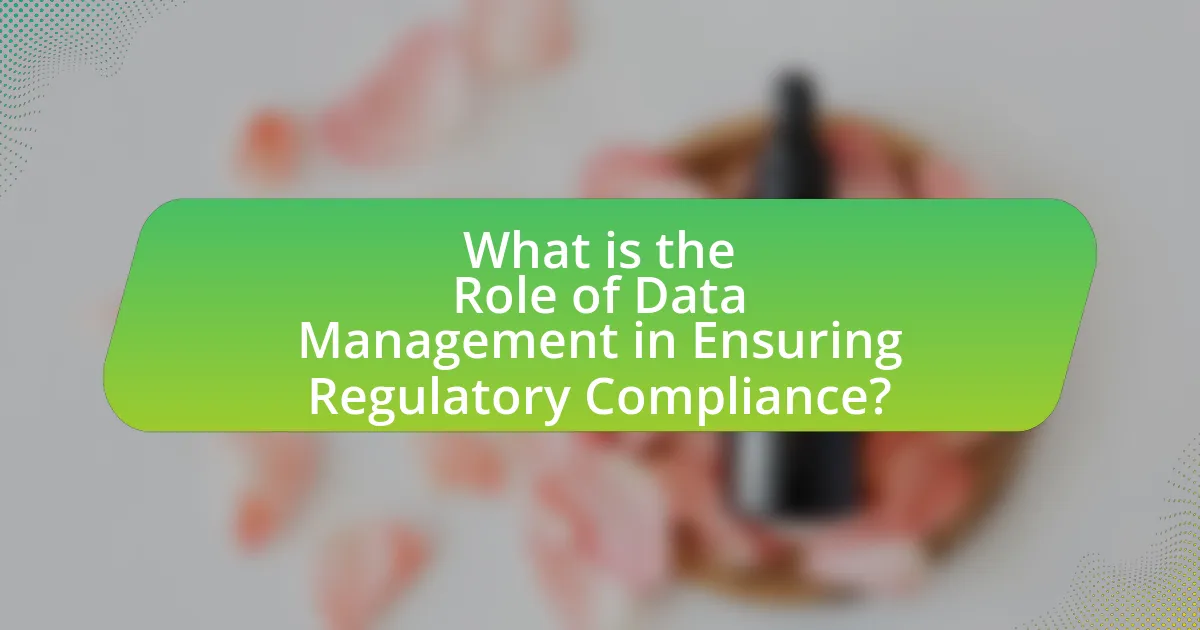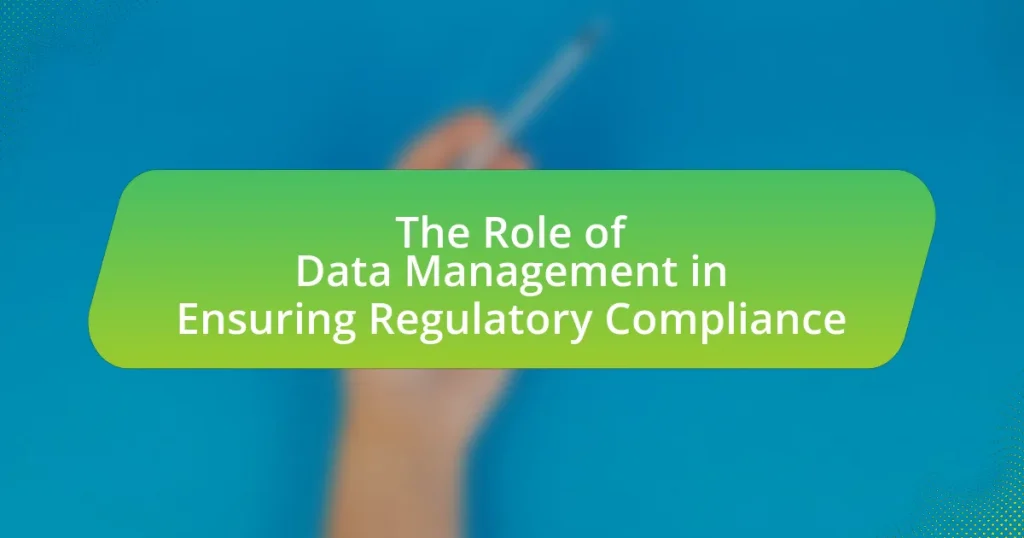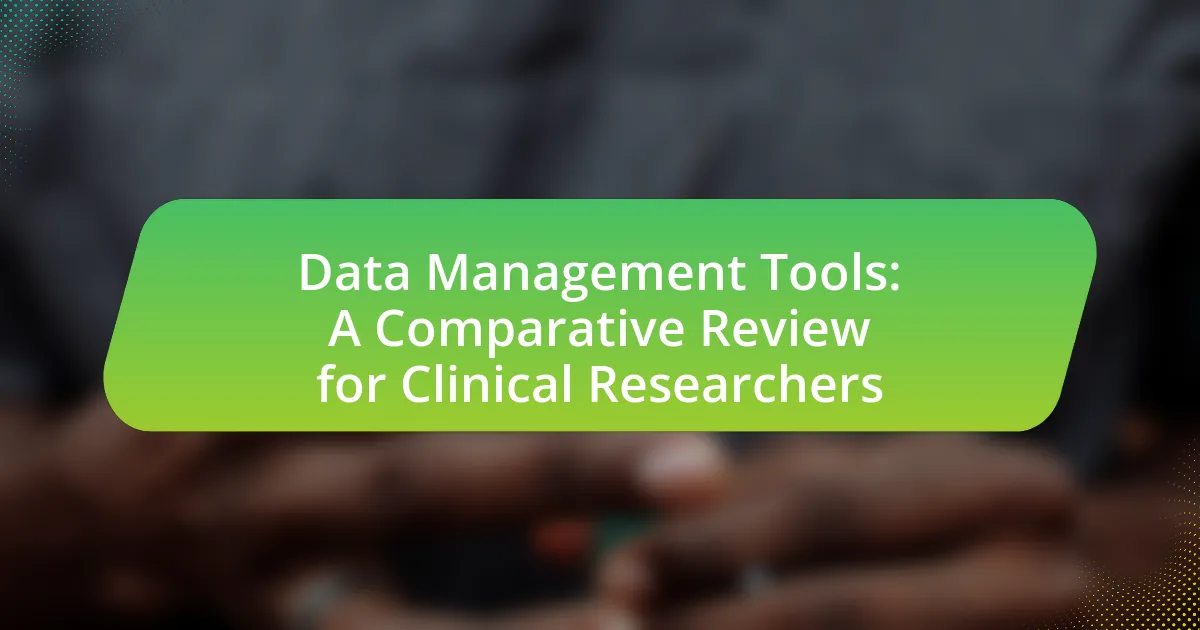Data management is essential for ensuring regulatory compliance by systematically organizing, storing, and protecting data in accordance with legal and industry standards. The article outlines how effective data management practices, including data governance, data quality, and data security, contribute to maintaining accurate records and facilitating audits, thereby mitigating compliance risks. It highlights the importance of adhering to regulations such as GDPR and HIPAA, the consequences of non-compliance, and the role of technology and automation in enhancing compliance efforts. Additionally, the article discusses best practices for data management, the significance of regular audits, and the training necessary for compliance teams to effectively navigate evolving regulatory landscapes.

What is the Role of Data Management in Ensuring Regulatory Compliance?
Data management plays a critical role in ensuring regulatory compliance by systematically organizing, storing, and protecting data to meet legal and industry standards. Effective data management practices, such as data governance, data quality, and data security, help organizations maintain accurate records, facilitate audits, and ensure that sensitive information is handled according to regulations like GDPR or HIPAA. For instance, a study by the Ponemon Institute found that organizations with robust data management strategies are 50% less likely to experience data breaches, highlighting the importance of data management in mitigating compliance risks.
How does data management contribute to regulatory compliance?
Data management contributes to regulatory compliance by ensuring that organizations systematically collect, store, and manage data in accordance with legal requirements. Effective data management practices, such as data governance, data quality, and data security, help organizations maintain accurate records, protect sensitive information, and facilitate audits. For instance, the General Data Protection Regulation (GDPR) mandates that organizations implement appropriate technical and organizational measures to ensure data protection, which can be achieved through robust data management strategies. Additionally, organizations that utilize data management systems can automate compliance reporting, reducing the risk of human error and ensuring timely submission of required documentation to regulatory bodies.
What are the key principles of data management relevant to compliance?
The key principles of data management relevant to compliance include data governance, data quality, data security, and data lifecycle management. Data governance establishes policies and procedures to ensure data is managed consistently and in accordance with regulations. Data quality focuses on maintaining accurate, complete, and reliable data, which is essential for compliance reporting. Data security involves protecting sensitive information from unauthorized access and breaches, aligning with regulations like GDPR and HIPAA. Data lifecycle management ensures that data is properly created, stored, archived, and disposed of, in compliance with legal requirements. These principles collectively support organizations in meeting regulatory obligations and minimizing risks associated with data handling.
How does effective data management mitigate compliance risks?
Effective data management mitigates compliance risks by ensuring accurate, timely, and secure handling of data, which is essential for adhering to regulatory requirements. By implementing structured data governance frameworks, organizations can maintain data integrity and traceability, thereby reducing the likelihood of non-compliance. For instance, a study by the Ponemon Institute found that organizations with robust data management practices experienced 50% fewer compliance violations compared to those with weaker systems. This demonstrates that effective data management not only safeguards sensitive information but also enhances an organization’s ability to meet legal and regulatory obligations efficiently.
Why is regulatory compliance important for organizations?
Regulatory compliance is important for organizations because it ensures adherence to laws and regulations, which mitigates legal risks and enhances operational integrity. Organizations that comply with regulations, such as the General Data Protection Regulation (GDPR) or the Health Insurance Portability and Accountability Act (HIPAA), avoid significant penalties that can reach millions of dollars. For instance, in 2020, companies faced over $1.3 billion in fines for GDPR violations, highlighting the financial implications of non-compliance. Furthermore, regulatory compliance fosters trust with customers and stakeholders, as it demonstrates a commitment to ethical practices and data protection. This trust can lead to increased customer loyalty and a competitive advantage in the market.
What are the consequences of non-compliance?
Non-compliance with regulatory standards can lead to significant legal and financial repercussions for organizations. These consequences may include hefty fines, which can range from thousands to millions of dollars depending on the severity of the violation, as evidenced by the General Data Protection Regulation (GDPR) fines that can reach up to 4% of annual global turnover. Additionally, non-compliance can result in legal actions, including lawsuits and sanctions, which can further damage an organization’s reputation and operational capabilities. Furthermore, organizations may face increased scrutiny from regulatory bodies, leading to more frequent audits and oversight, which can strain resources and disrupt business operations.
How does compliance impact organizational reputation?
Compliance significantly enhances organizational reputation by demonstrating a commitment to ethical practices and legal standards. Organizations that adhere to regulations are perceived as trustworthy and responsible, which fosters customer loyalty and attracts investors. For instance, a study by the Harvard Business Review found that companies with strong compliance programs experience a 20% increase in customer trust and a 15% rise in employee satisfaction. This positive perception can lead to competitive advantages, as stakeholders are more likely to engage with organizations that prioritize compliance, thereby reinforcing their reputation in the marketplace.

What are the key components of data management for compliance?
The key components of data management for compliance include data governance, data quality, data security, and data lifecycle management. Data governance establishes policies and procedures to ensure data integrity and compliance with regulations. Data quality focuses on maintaining accurate and reliable data, which is essential for compliance reporting. Data security involves protecting sensitive information from unauthorized access and breaches, aligning with regulations such as GDPR and HIPAA. Data lifecycle management ensures that data is properly created, stored, archived, and disposed of in accordance with compliance requirements. These components work together to create a robust framework that supports regulatory compliance and mitigates risks associated with data management.
How do data governance frameworks support compliance efforts?
Data governance frameworks support compliance efforts by establishing structured policies and procedures that ensure data management aligns with regulatory requirements. These frameworks provide clear guidelines for data handling, access, and security, which are essential for meeting legal standards such as GDPR and HIPAA. For instance, organizations implementing a data governance framework can systematically document data lineage and maintain audit trails, facilitating compliance audits and demonstrating accountability. This structured approach not only mitigates risks associated with data breaches but also enhances the organization’s ability to respond to regulatory changes effectively, thereby reinforcing compliance efforts.
What roles do data quality and integrity play in compliance?
Data quality and integrity are critical in compliance as they ensure that organizations meet regulatory requirements accurately and consistently. High data quality minimizes errors and discrepancies, which can lead to non-compliance and potential legal penalties. For instance, the Sarbanes-Oxley Act mandates accurate financial reporting, and organizations must maintain data integrity to avoid misrepresentation. Furthermore, regulatory bodies often require audits that rely on the accuracy of data; thus, maintaining high standards of data quality and integrity is essential for demonstrating compliance and building trust with stakeholders.
How can organizations implement effective data governance?
Organizations can implement effective data governance by establishing a clear framework that includes policies, procedures, and roles for data management. This framework should define data ownership, data quality standards, and compliance requirements, ensuring that all data-related activities align with regulatory obligations. For instance, a study by the Data Governance Institute highlights that organizations with defined data governance frameworks experience a 30% improvement in data quality and compliance adherence. By regularly training staff on these policies and utilizing technology for data monitoring and reporting, organizations can maintain accountability and transparency in their data governance practices.
What technologies enhance data management for regulatory compliance?
Technologies that enhance data management for regulatory compliance include data governance platforms, data analytics tools, and cloud-based storage solutions. Data governance platforms, such as Collibra and Informatica, provide frameworks for managing data quality, lineage, and access controls, ensuring compliance with regulations like GDPR and HIPAA. Data analytics tools, including Tableau and Power BI, enable organizations to analyze and visualize data for compliance reporting, helping to identify risks and ensure adherence to regulatory requirements. Cloud-based storage solutions, such as AWS and Microsoft Azure, offer secure data storage and management capabilities, facilitating compliance with data protection regulations through features like encryption and access management. These technologies collectively support organizations in maintaining regulatory compliance by improving data accuracy, accessibility, and security.
How do data analytics tools assist in compliance monitoring?
Data analytics tools assist in compliance monitoring by automating the collection, analysis, and reporting of data relevant to regulatory requirements. These tools enable organizations to identify compliance risks, track adherence to regulations, and generate reports that demonstrate compliance status. For instance, according to a report by Deloitte, 80% of organizations using data analytics for compliance monitoring reported improved efficiency in their compliance processes. This efficiency stems from the ability of analytics tools to process large volumes of data quickly, flag anomalies, and provide insights that help organizations proactively address compliance issues.
What role does automation play in data management for compliance?
Automation plays a crucial role in data management for compliance by streamlining processes, reducing human error, and ensuring consistent adherence to regulatory requirements. Automated systems can efficiently collect, store, and analyze data, enabling organizations to maintain accurate records and generate compliance reports in real-time. For instance, according to a report by Deloitte, companies that implement automation in compliance processes can reduce compliance costs by up to 30% and improve accuracy by minimizing manual data entry errors. This efficiency not only enhances compliance but also allows organizations to respond swiftly to regulatory changes, thereby maintaining their compliance posture effectively.

What challenges do organizations face in data management for compliance?
Organizations face significant challenges in data management for compliance, primarily due to the complexity of regulatory requirements. These regulations often vary by industry and region, making it difficult for organizations to maintain up-to-date knowledge and ensure adherence. Additionally, the volume of data generated and stored can overwhelm existing data management systems, leading to difficulties in data retrieval and reporting.
Moreover, organizations struggle with data quality issues, as inaccurate or incomplete data can result in non-compliance penalties. The integration of disparate data sources also poses a challenge, as inconsistent data formats and structures complicate compliance efforts. Finally, the rapid pace of technological change requires organizations to continuously adapt their data management practices, which can strain resources and expertise.
How can organizations overcome data silos in compliance efforts?
Organizations can overcome data silos in compliance efforts by implementing integrated data management systems that facilitate seamless data sharing across departments. These systems enable real-time access to compliance-related information, ensuring that all relevant stakeholders have the necessary data to meet regulatory requirements. For instance, a study by Gartner highlights that organizations with integrated data management practices experience a 30% reduction in compliance-related errors, demonstrating the effectiveness of such systems in breaking down silos. Additionally, fostering a culture of collaboration and communication among teams can further enhance data sharing and compliance adherence.
What strategies can be employed to ensure data consistency across departments?
To ensure data consistency across departments, organizations can implement standardized data governance frameworks. These frameworks establish clear policies, procedures, and responsibilities for data management, ensuring that all departments adhere to the same data definitions and formats. For instance, the Data Management Association (DAMA) emphasizes the importance of data governance in maintaining data integrity and consistency across various business units. Additionally, utilizing centralized data repositories and integrated software solutions can facilitate real-time data sharing and updates, further promoting consistency. Research shows that organizations with strong data governance practices experience 30% fewer data-related issues, highlighting the effectiveness of these strategies in achieving data consistency.
How can organizations address evolving regulatory requirements?
Organizations can address evolving regulatory requirements by implementing robust data management systems that ensure compliance and adaptability. These systems facilitate real-time monitoring of regulatory changes, enabling organizations to update their policies and procedures accordingly. For instance, a study by the International Compliance Association highlights that organizations with integrated data management frameworks are 30% more likely to remain compliant with new regulations. By leveraging technology such as automated compliance tools and data analytics, organizations can streamline their processes, reduce risks, and enhance their ability to respond to regulatory shifts effectively.
What best practices should organizations follow for effective data management in compliance?
Organizations should implement a comprehensive data governance framework to ensure effective data management in compliance. This framework should include clear data ownership, data classification, and data lifecycle management policies. For instance, establishing data stewardship roles helps maintain accountability and ensures that data is accurate and secure. Additionally, organizations must conduct regular audits and risk assessments to identify compliance gaps and mitigate potential risks. According to a study by the International Association for Privacy Professionals, organizations that actively manage their data compliance processes reduce the likelihood of data breaches by up to 50%. Furthermore, training employees on data protection regulations and best practices fosters a culture of compliance, enhancing overall data management effectiveness.
How can regular audits improve data management practices?
Regular audits enhance data management practices by identifying inconsistencies, ensuring compliance, and promoting data integrity. Through systematic evaluations, audits reveal gaps in data handling processes, which can lead to improved protocols and adherence to regulatory standards. For instance, a study by the International Data Management Association found that organizations conducting regular audits experienced a 30% reduction in compliance-related issues. This demonstrates that regular audits not only strengthen data governance but also foster a culture of accountability and continuous improvement in data management practices.
What training and resources are essential for compliance teams?
Compliance teams require specialized training in regulatory frameworks, risk management, and data protection laws, along with resources such as compliance management software and access to legal databases. Training programs should cover topics like GDPR, HIPAA, and industry-specific regulations to ensure team members understand compliance requirements. Resources like compliance management tools facilitate tracking and reporting, while legal databases provide up-to-date information on regulatory changes. These elements are essential for maintaining effective compliance practices and mitigating risks associated with non-compliance.






